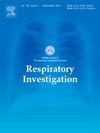Benefit of antifibrotic therapy initiated during acute exacerbation of interstitial lung disease: A systematic review
IF 2.4
Q2 RESPIRATORY SYSTEM
引用次数: 0
Abstract
Background
Acute exacerbations of interstitial lung disease (AE-ILD) are associated with significant morbidity and mortality. While corticosteroids are commonly used in the treatment, their optimal dose, duration, and overall benefit remain unclear. This systematic review evaluates the efficacy of antifibrotic medications (nintedanib and pirfenidone) when initiated during or immediately after AE-ILD.
Methods
We conducted a systematic search across MEDLINE, EMBASE, and Cochrane databases through January 2025. Studies comparing antifibrotic medications to standard care in AE-ILD were included. Primary outcomes were survival rates, hospitalization duration, and AE-ILD recurrence. Quality assessment was performed using the Newcastle-Ottawa Scale.
Results
Four observational studies from Japan comprising 6321 patients met the inclusion criteria. Nintedanib was associated with significantly reduced in-hospital mortality (7.1 % vs. 15.1 %, p < 0.001) and shorter hospitalization duration (30.7 ± 13.7 vs. 37.5 ± 19.0 days, p < 0.001) in one large study (n = 6235). A second nintedanib study demonstrated lower 90-day mortality (36.36 % vs. 54.55 %, p = 0.048) and delayed time to subsequent exacerbations. Two smaller studies evaluating pirfenidone showed trends toward improved 90-day survival that did not reach statistical significance (64.3 % vs. 52.9 %, p = 0.72; 44 % vs. 34 %, p = 0.391). Reported adverse events were consistent with known safety profiles of these medications.
Conclusion
Current evidence suggests nintedanib may reduce mortality and hospitalization duration in AE-ILD, while pirfenidone's benefits remain inconclusive. These findings are limited by the observational nature of the studies, variability in AE-ILD definitions, and limited geographical representation. Well-designed randomized controlled trials are needed to confirm these preliminary findings and establish optimal treatment protocols for AE-ILD.
间质性肺疾病急性加重期开始抗纤维化治疗的益处:一项系统综述
背景:间质性肺疾病急性加重(AE-ILD)与显著的发病率和死亡率相关。虽然皮质类固醇通常用于治疗,但其最佳剂量、持续时间和总体效益仍不清楚。本系统综述评估了在AE-ILD期间或之后立即使用抗纤维化药物(尼达尼布和吡非尼酮)的疗效。方法:我们对MEDLINE、EMBASE和Cochrane数据库进行了系统检索,检索时间截止到2025年1月。比较抗纤维化药物与AE-ILD标准治疗的研究被纳入。主要结局是生存率、住院时间和AE-ILD复发率。使用纽卡斯尔-渥太华量表进行质量评估。结果来自日本的4项观察性研究包括6321例患者符合纳入标准。尼达尼布与显著降低住院死亡率相关(7.1% vs 15.1%, p <;0.001)和更短的住院时间(30.7±13.7 vs. 37.5±19.0天,p <;0.001),在一项大型研究中(n = 6235)。第二项尼达尼布研究显示,90天死亡率较低(36.36% vs. 54.55%, p = 0.048),并延迟了随后加重的时间。两项较小的评估吡非尼酮的研究显示,90天生存率的改善趋势没有达到统计学意义(64.3%对52.9%,p = 0.72;44% vs. 34%, p = 0.391)。报告的不良事件与已知的这些药物的安全性一致。结论:目前的证据表明尼达尼布可降低AE-ILD的死亡率和住院时间,而吡非尼酮的益处仍不确定。这些发现受到研究的观察性、AE-ILD定义的可变性和有限的地理代表性的限制。需要精心设计的随机对照试验来证实这些初步发现,并建立AE-ILD的最佳治疗方案。
本文章由计算机程序翻译,如有差异,请以英文原文为准。
求助全文
约1分钟内获得全文
求助全文

 求助内容:
求助内容: 应助结果提醒方式:
应助结果提醒方式:


